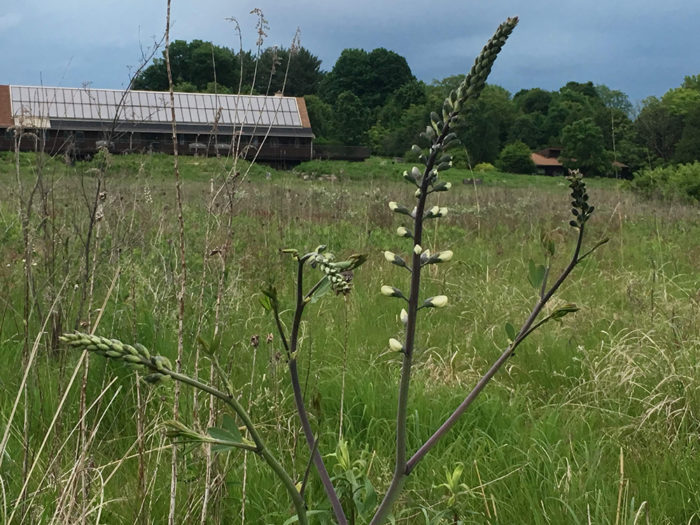
As gardeners and plant lovers, we all take cues from natural areas nearby to inspire our plant selections, combinations, and garden aesthetic. Living in Madison, Wisconsin, I cannot think of a more beautiful synergy between a natural archetype and a deft human hand than the world’s first ecologically restored prairie. The Curtis Prairie at the University of Wisconsin Arboretum, initially planted on agricultural land in 1934, was a groundbreaking experiment in recreating the species diversity and natural systems of our decimated prairie landscapes. It continues to be an important site of study and exploration of prairie ecosystems and also happens to feature one of my favorite native plants: white false indigo (Baptisia alba var. macrophylla, Zones 3–9).
Although prairies are often thought to peak later in the summer, my favorite denizen of the Curtis Prairie makes her graceful entry in late spring. In late May and early June, succulent purple-gray stems begin to rise above the 12-inch-tall layer of grasses and forbs below. Branched, candelabra-like spires of creamy white flowers highlighted by dusky sepals follow, dotted like moonlight through the wide open space. To describe white false indigo as simply a lovely plant is a significant understatement.

This false indigo is distinguished from its more widely planted blue cousins not only by the coloration of its flowers, but also by its earlier bloom time and more open habit. Blue false indigo (Baptisia australis, Zones 3-9) and its cultivars grow into a sturdy vaselike form, resembling small shrubs in the landscape. White false indigo, however, is more wiry, with looser branching patterns that weave well and emerge through other midsize perennials. Even just one freestanding plant is a statement with its architectural form. It also exhibits greater tolerance of moist conditions than other Baptisia and can even be used with success on the upper edges of rain gardens.
Its extensive native range throughout the eastern United States from Texas to Canada also speaks to the wide adaptability of white false indigo. This wide distribution has led to confusion in nomenclature, with regional southern forms going by B. alba var. alba and B. albescens. Regardless of the name you find it labeled under, white false indigo does share many characteristics with other members of the Baptisia genus. Its nascent flowers are waiting on the stems even as they emerge from the soil in May, so watch carefully to avoid stepping on them, and consider caging if rabbits are a problem in your garden. Deep-rooted false indigo typically resents transplanting, so put thought into its placement. After the flowers fade, the plant remains attractive with its black, beanlike seedpods highlighted against the gray foliage. Like other false indigo varieties, this is a super-easy-to-grow and long-lived plant that will slowly size up to become a unique and notable addition in your garden.
Erin Presley is a horticulturist at Olbrich Botanical Gardens in Madison, Wisconsin.


















Comments
Log in or create an account to post a comment.
Sign up Log in